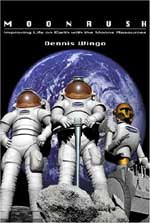
The main doomsday premise is the exhaustion of the supply of high density, easily transportable energy (read oil and gas). Not only is this supply nearing exhaustion, but the overall population of human beings is still climbing. Using a number of case studies, the reader is shown that the Earth, as a closed system, can’t support the status quo. We either need less people, a lower quality of life or more Earths. The last option, crazy as it sounds, is exactly what Wingo is proposing. Within our Solar System, there are bodies that contain many of the elements that are mined on Earth. These include the rare and valuable platinum group metals, especially palladium, which play a key role in today’s economy and would do so even more in a future hydrogen based economy. Thus we have a proposed solution to the envisioned energy doomsday; that is, to mine for the required minerals on asteroids, comets and moons.
Wingo takes the reader on a whirlwind tour of the history of lunar exploration and present day space flight capability (there’s plenty of wailing and gnashing of teeth about the unproductive Apollo missions and the total lack of interest in lunar exploration). By using the results from the Apollo missions and the Clementine and Lunar Prospector missions, Wingo makes a strong case for lunar mining. As a response to the doomsday premise and using the data gathered by these spacecraft, we’re presented with plans to use existing technology to get mining on the Moon. A detailed $16 billion list of components and techniques follows to explain exactly what would get done. Wingo thinks that governments need to provide incentives, minimize obstacles and encourage private enterprise to get mining.
The title is well suited. Like the earlier gold rushes in North America that did so much to open up tracts of land, a Moon rush, with people headed to the Moon to bring minerals back to Earth can also lead to all kinds of innovations. Further, by extracting, smelting and refining off-Earth, we can keep the harmful waste away too. This would be another benefit to life on Earth, as the subtitle states.
The book’s prose lacks a bit. It’s kind of repetitive and I got the impression that it’s a cleaned up version of someone’s class notes. There’s quite a lot of extraneous information, like completely describing the Otto cycle internal combustion engine, and a lengthy study of the stock prices of Boeing and Microsoft. I get how they’re relevant, but I’m not sure it was the best use of space and focus. Still, the chapters are clear and well laid out.
I liked Moonrush. It’s not too technical, and there isn’t a lot of hand waving. The premise is clear and well supported. The historical perspective lends credence and vision. Finally, Wingo does a great job of describing vehicles and methodology that ring true to me (as an armchair Moon miner).
Although Moonrush – Improving Life on Earth with the Moon’s Resources starts on a sour note – you know, the impending doom of the human race – it’s really a positive book that shows how Dennis Wingo has enthusiasm and faith that private enterprise will help get us back to the Moon with 21st century pickaxes and shovels to get the minerals we need without having to wreck our own environment. Maybe doom won’t be around the corner after all. If Paul Allen’s got some pocket change left over, he’d be well advised to kick some cash to help harvest the Moon’s resources.
To read more reviews, or order the book online, visit Amazon.com.
Review by Mark Mortimer
